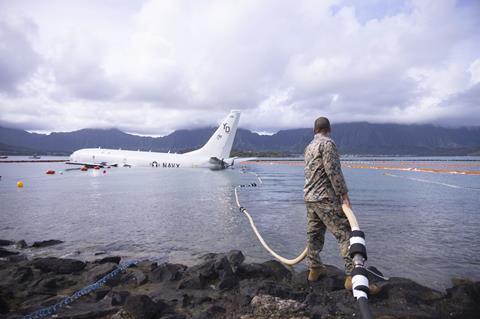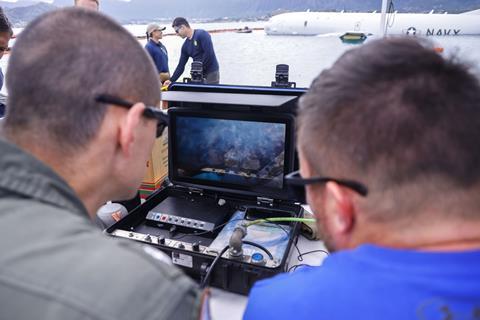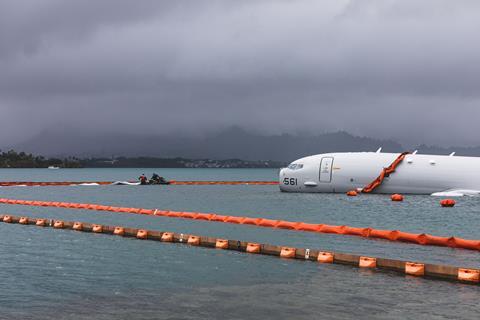The US Navy (USN) hopes to return a crashed Boeing P-8 Poseidon maritime patrol jet to flight status, following a mishap in Hawaii that left the aircraft partially submerged in ocean water.
In a 27 November update on salvage operations, navy officials said Poseidon number 561 remains structurally intact, including the aircraft’s fuel system, which has been successfully drained.
“We will do everything we can to retain the operational capabilities of this aircraft,” says Rear Admiral Kevin Lenox, commander of the USN’s 3rd Carrier Strike Group.

Poseidon number 561 overshot its landing on 20 November while touching down at Marine Corps Air Station Kaneohe on the island of Oahu. The aircraft settled partially submerged in shallow water just offshore from the coastal runway.
No injuries or fatalities were reported in connection with the incident.
The USN has not yet offered any cause for the mishap, but divers successfully recovered the P-8’s flight data recorder and an investigation is underway.
Lenox says salvage divers from the nearby Pearl Harbor naval base were able to remove some 7,570 litres (2,000USgal) of jet fuel from the crashed P-8, without any contamination of the surrounding environment.
The two-star admiral adds the USN is conducting “extensive technical analysis” with specialists in both salvage operations and aircraft engineering, with the goal of removing the P-8 “as soon as possible”.
Notably, a survey by salvage divers has concluded that the jet’s landing gear remain intact and are currently supporting the aircraft body.
“The aircraft is in remarkably good condition,” says Lenox. “It has full integrity.”
Lead diver Commander Mark Anderson says the P-8 is resting on a mix of coral and sand, and retains positive buoyancy – rising and falling slightly with the local tide.
Divers have anchored the jet in place, while the USN determines the best method of returning it to dry land.
Lenox says, given the structurally intact landing gear, two options are being considered. The first is to use salvage floats to lift the P-8 from its resting place and push the aircraft within range of a ground-based crane, which would then lift it back onto the runway.
The second option would use salvage floats to lift the P-8, which would then be rolled to shore using its landing gear.
Lenox says a number of factors, including weather and environmental concerns, will determine which method is selected.
Once the aircraft has been removed from the water, it will be stored at the Marine Corps air station to assist investigators in determining the cause of the accident. After the investigation is completed, the USN will begin the repair process.
“The P-8 is an essential part of our fleet and the navy’s mission,” Lenox says of the ground-based patrol jet.
The USN has 116 Poseidons in service, according to Cirum data.





























